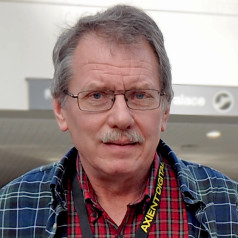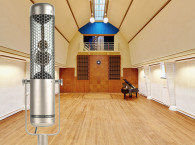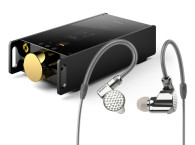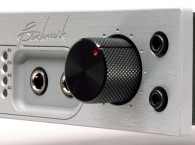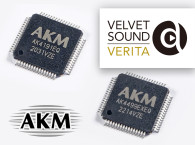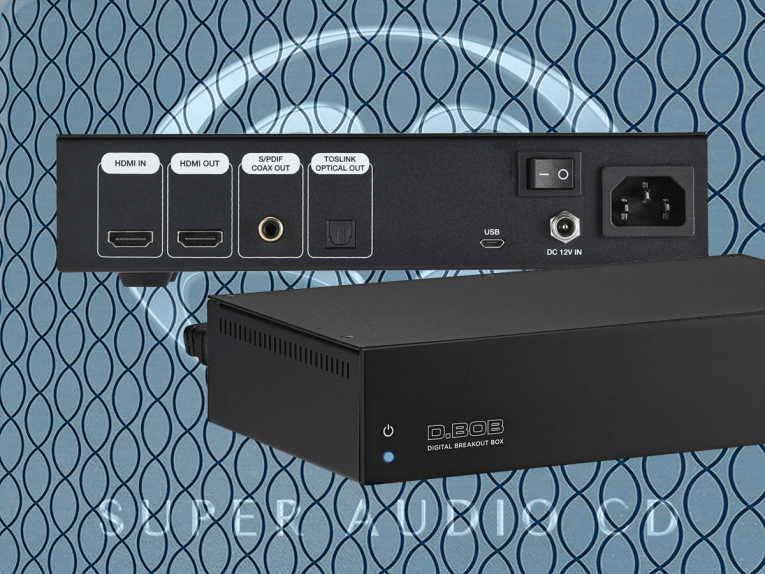
Unfortunately, the recording industry’s paranoia about copyright protection — not entirely unjustified — has made it impossible for most players to send high-resolution datastreams to outboard DACs via S/PDIF. High-resolution Blu-Ray and DVD-Audio discs with copy-protection are normally down-sampled to 44.1 kHz or 48 kHz. But, players normally leave the HDMI datastream unchanged, since there’s no way an end user can access the audio data.
The work around for this problem has been an HDMI audio de-embedder. A de-embedder extracts full PCM resolution from the HDMI datastream and sends it to an outboard DAC via S/PDIF. I reviewed the KanexPro HAECOAX de-embedder in the July 2016 issue of audioXpress, and have since used de-embedders sold by Tripp-Lite (P130-000-AUDIO) and Monoprice (10251). Monoprice calls its unit an HDMI Audio Converter, and the unit it carries is also sold as the ProLink HA-110SA. It’s currently my favorite of the three, providing cleaner, more detailed sound than the KanexPro and Tripp-Lite.
DSD Solution
Unfortunately, none of the HDMI audio de-embedders have been able to extract the DSD datastream from SACDs. I’ve normally used my OPPO Digital players as stand-alone units when playing SACDs, feeding the player’s analog outputs directly to my preamp. Some audiophiles set their players to convert DSD into 24-bit PCM, so they can use their outboard DACs. But, the conversion is a compromise, partly because every player I’ve used converts the DSD to 88.2 kHz. In order to preserve something close to the full bandwidth of DSD, and consequently the lowest phase distortion in the audible spectrum, the conversion should be to 176.4 kHz. I have lamented the inability to decode my SACDs in my outboard DAC, native mode, in several of my reviews.
GeerFab Audio to the rescue! This Wisconsin-based firm is a the sister company of GeerFab Acoustics, which manufactures acoustical treatment products. Owner/designer Eric Geer shared my own frustrations about SACD playback and decided to take matters into his own hands. After three years of research and development, the result is the D.BOB Digital Breakout Box (see Photo 1). On PCM sources, the D.BOB functions exactly like any other HDMI audio de-embedder.
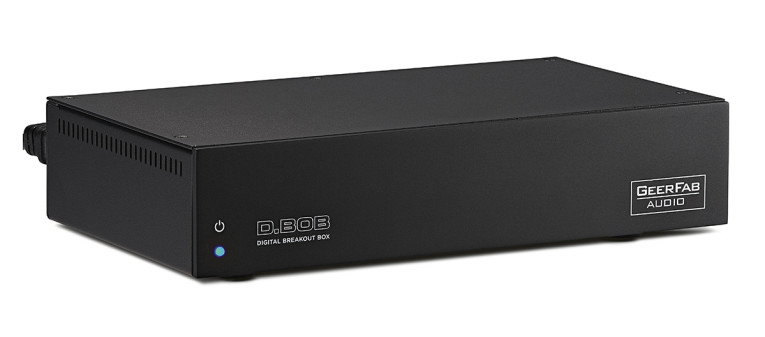
PCM audio is extracted from the HDMI datastream and output over S/PDIF in full resolution — up to 192 kHz/24-bit. But, that’s where the comparison ends. The D.BOB is the first de-embedder that will also extract DSD from the HDMI audio data. DSD is encoded on an S/PDIF datastream using the DoP protocol. DoP is short for “DSD over PCM” and was initially developed by dCS, a well-known manufacturer of high-performance digital audio converters.
A detailed explanation can be found on the DSD Guide website, but dCS has summarized the system nicely: “The original idea for DoP was invented by dCS in 2011. It involves taking groups of 16 adjacent 1-bit samples from a DSD stream and packing them into the lower 16 bits of a 24/176.4 datastream. Data from the other channel of the stereo pair is packed the same way. A specific marker code in the top 8 bits identifies the datastream as DoP, rather than PCM. The resulting DoP stream can be transmitted through existing 24/192-capable USB, AES, Dual AES or SPDIF interfaces to a DoP-compatible DAC, which reassembles the original stereo DSD datastream COMPLETELY UNCHANGED. If something goes wrong and the datastream is decoded as PCM, the output will be low-level noise with faint music in the background, so it fails safely. This can happen if the computer erases the marker code by applying a volume adjustment.”
DoP is widely used in computer audio systems via a USB connection to an outboard DAC. But, the D.BOB is the first product to implement DoP between a standalone SACD player and a DAC. What’s kept other audio manufacturers from doing this is fear of lawsuits from the recording industry. GeerFab was able to market the D.BOB by keeping the copy protection intact, a problem that occupied a great deal of product development time. GeerFab notes that one SACD manufacturer — Channel Classics —expressed enthusiasm about the D.BOB. They believe that offering audio enthusiasts a way to get better sound from their SACDs will help sell more discs — a very sensible attitude. It will probably help sell outboard DACs, as well, since many now support the DoP protocol.
The D.BOB’s connectivity is simple, as shown in Photo 2. There are two HDMI connectors — an input from the player and an output. The output is a pass-through that can be fed to a television, for players that don’t have separate audio and video outputs. There are also two output connectors — S/PDIF coaxial and Toslink optical. DoP will work via Toslink, but the most exotic cables aren’t always the most reliable. If possible, use coax for the best performance.
GeerFab wanted to include a USB output, but it wasn’t possible to keep the copy protection intact via USB. The D.BOB is normally powered directly from an AC wall outlet, but GeerFab also includes a 12 VDC input, for those who might wish to experiment with high-end, outboard power supplies. There’s also a Micro USB connector on the rear panel, for firmware updates.
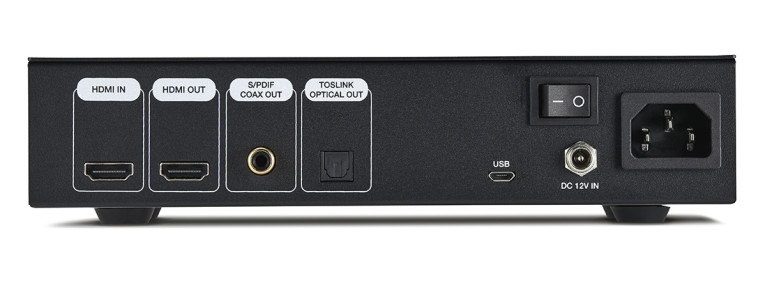
Design Details
The D.BOB design is centered around two chips made by Lattice Semiconductor (see Photo 3). The Sil9533 Port Processor is the main HDMI decoder chip, which extracts PCM audio data from the HDMI datastream and sends it out via S/PDIF. The HDMI pass-through functions are also supported by this chip. But, the Sil9533 does not support DSD. The DSD datastream is extracted from HDMI, and encoded as DoP, by a Lattice LCMX02-1200HC Field Programmable Gate Array (FPGA).
All the DSD extraction and encoding to DoP is handled by the custom programming of this chip. From the datasheets for these chips, it appears that the FPGA chip is connected as a loop in and out of the Port Processor. The Port Processor’s S/PDIF output is fed to a 74HC04 Hex Inverter, used as the S/PDIF driver, divided between the coaxial and Toslink outputs. The internal switching-mode power supply feeds 12 VDC to the main PC board, where it’s regulated to 5 VDC and filtered.
Performance
When I received my D.BOB review sample, it didn’t work with my Benchmark DAC3 HGC. When I played SACDs, the Benchmark DAC front panel LEDs indicated that it was receiving both PCM and DSD datastreams. Eric Geer and John Siau at Benchmark worked together to help solve the problem. In the end, the factory in China discovered a programming error in the FPGA chip.
Some DACs weren’t bothered by it, but the Benchmark was (the Benchmark uses a very strict implementation of the DoP protocol, requiring “by the book” timing of the markers that identify the datastream as DSD). This wholesale reprogramming of the FPGA chip isn’t possible using the rear-panel USB connector—it must be done through a six-pad connection on the PC board. My D.BOB was updated by GeerFab at his Wisconsin facility.
As I see it, there are three areas of comparison that are important in evaluating the D.BOB, which I’ll address one at a time. First, how do SACDs played through the D.BOB and my Benchmark DAC3 HGC compare to using my OPPO UDP-205 as a stand-alone player? Anyone who has gone from a stand-alone player to a good outboard DAC with PCM sources knows what to expect, and the improvement with DSD sources is no different.
With SACDs and DSD files, nearly every aspect of performance is improved. The soundstage is larger and more precise, with considerably more depth. There is great inner detail, and a greater sense of the connecting acoustical space between instruments and sections of the orchestra. The bass is more extended and better defined, and the treble region is more open and airy. Dynamics are also improved.
Second, how do SACDs played through the D.BOB and the Benchmark DAC, as native DSD, compare to having my OPPO player convert them to 88.2 kHz/24-bit PCM? Converting SACDs and DSD files to 88.2 kHz/24-bit and feeding the PCM datastream to the Benchmark has always been a mixed bag. The soundstage is improved—larger and better defined, with greater depth. But, the treble region loses some of the analog-like smoothness that’s one of the hallmarks of DSD. Using the D.BOB with native DSD conversion gives you the best of both worlds, and more. The positive aspects of the PCM conversion are further improved and the analog-like smoothness is delivered in full measure.
Third, how do DSD 64 files played through the D.BOB compare to the same files played from a phone or tablet, fed via USB to an outboard DAC? The D.BOB will also decode DSD files played on an external drive—I use the OPPO UDP-205 as the server. I have some of the same files on an extra memory card in my Samsung Galaxy Note 4, which I play with an app called USB Audio Player Pro. I also own two commercial SACDs that were made from those files.
The phone is connected to the Benchmark DAC3 with a short RadioShack USB “On The Go” adapter and a DH Labs Mirage USB interconnect. I always suspected that the phone was not an ideal source for file playback. I have done several comparisons of PCM material played on my phone, with the same files played through my OPPO. The OPPO simply delivers a cleaner and more refined sound. The same is true of DSD sources.
File playback on the phone reveals many of the improvements I hear with native decoding of SACDs and DSD files through the OPPO and D.BOB, especially the sound staging and spatial qualities. But, the sound through the phone is somewhat veiled and lacking fine detail. Playback through the OPPO and D.BOB removes a fine layer of grunge that I hear with the phone. As an HDMI de-embedder for PCM sources, up to 192 kHz, the D.BOB is at least as transparent as the Monoprice, and perhaps even a bit better.
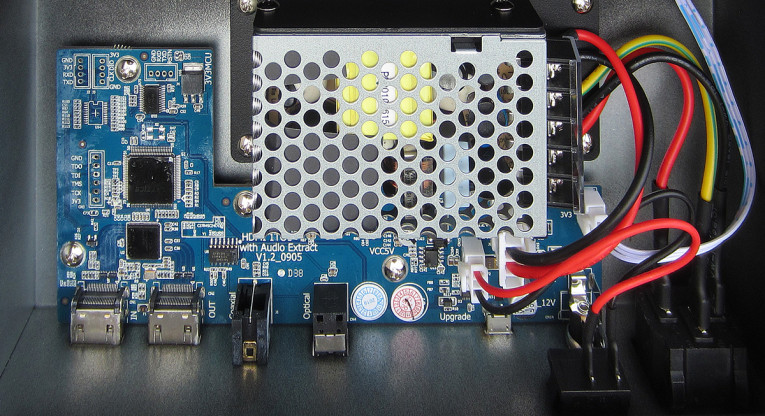
DSD Quirks
DSD, especially over DoP, is not without its quirks. The D.BOB is an entirely new implementation of DoP, and users may experience a minor glitch or two with some SACD players. With my OPPO UDP-205, if I start by playing an SACD or DSD file after powering up, I hear a click through the system before playback starts. It’s about the level of a loud click on an LP, but nothing that could be damaging. I get the same click if I play a 44.1 kHz source first, and then play a DSD source. I don’t hear the click going from any other PCM sampling rate to DSD. On occasion, when I start an SACD or DSD file, I’ll hear soft static on top of the music, similar to what dCS describes in the statement I cited earlier. If I eject the disc and reload, the problem disappears. Once an SACD properly starts, it will play fine from beginning to end.
GeerFab loaned me a Sony UDP-X700 and I had no problems with it. Benchmark uses an older OPPO DV-980H and Siau says they haven’t had any problems (they kept their DV-980H because it doesn’t down sample high-res PCM sources via S/PDIF). I did experience both the click and the static issues with my wife’s OPPO BDP-93, and GeerFab reports occasional glitches with his OPPO BDP-105. So, these issues may be unique to certain players, and would not appear to be a problem with the D.BOB.
Siau notes that bursts of noise are a common occurrence when playing DSD, especially when the playback system is toggled between PCM and DSD. It’s exceedingly difficult to build soft mute circuits in a 1-bit DSD environment. For this reason, players tend to do a hard switch when starting a new track. When DSD is passed from box to box, these problems are magnified. The DAC2 and DAC3 have soft mute circuits that are active when playing DSD, but pops, clicks, and bursts of noise can be produced by upstream DSD players and/or interface devices.
Correct audio settings on your player are critical to getting the best performance, and you may have to experiment. Make sure that the selected HDMI audio output is the one connected to the D.BOB. SACD modes should be Stereo and DSD, and HDMI audio format will usually be Auto. I consider the issues I experienced to be minor — far outweighed by the remarkable performance improvements the D.BOB delivers with DSD sources.
Conclusions
For audiophiles who are SACD fans and who use an outboard DAC, the D.BOB is the product we’ve awaited. The remarkable improvement in sound quality afforded by decoding SACDs, native mode, with a high-performance outboard DAC, is remarkable. I’m sure, like me, you’ll spend many hours rediscovering your SACD collection.
The price is admittedly a bit high — higher than many of the players with which it’s likely to be used. But, being the first of its kind, considerable expense has gone into its development. Contrary to Sony’s hopes, the SACD format has not become mainstream — it remains a specialty, audiophile format. Whether other equipment manufacturers will introduce similar products, now that GeerFab has broken the ice, remains to be seen (a patent is pending on the D.BOB design). If you’re serious about SACD playback, you’re going to want the D.BOB. aX
This article was originally published in audioXpress, October 2020.
GeerFab Audio
173 West Bergen Drive
Fox Point, WI 53217
(414) 446-5841
geerfab.com/geerfab-audio
Price: $999 US
Resources
G. Galo, “OPPO Digital UDP-205,” audioXpress, November 2017,
———, “Benchmark DAC3 HGC Stereo D/A Converter,” audioXpress, July 2017,
———, “KanexPro HAECOAX HDMI Audio De-Embedder,” audioXpress, July 2016
———, “OPPO Digital’s New 3-D Blu-ray Disc Player Raises the Bar” (BDP-105), audioXpress, October 2013.
———, “OPPO BDP-95 Universal Network 3D Blu-Ray Disc Player,” audioXpress, January 2012.
———, “OPPO Digital BDP-93 Blu-ray Disc Player,” audioXpress, June 2011.
Sources
Benchmark Media Systems www.benchmarkmedia.com
Data Conversion Systems - www.dcsltd.co.uk/support/what-is-dop-dsd-over-pcm
DoP DSD Guide https://dsd-guide.com/dop-open-standard
Monoprice HDMI Audio Converter www.monoprice.com/product?p_id=10251
Silver Sonic DH Labs | https://silversonic.com
USB Audio Player Pro - Audio Evolution Mobile Studio | www.extreamsd.com/index.php/products/usb-audio-player-pro


